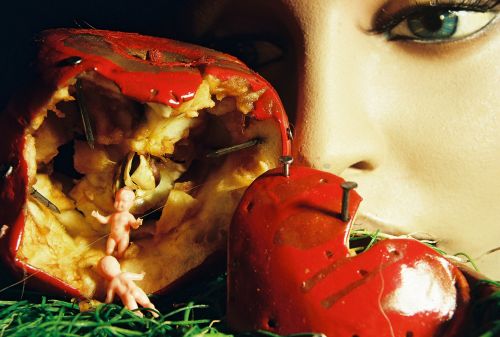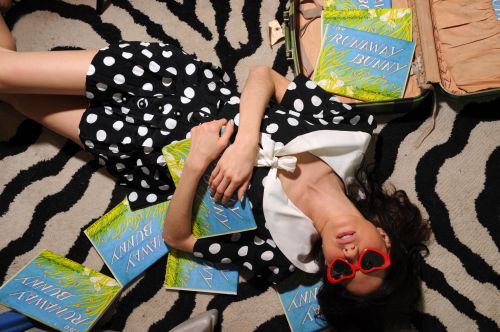
Kelsey Bennett, “Apple,” C-print, 2009
KELSEY BENNETT: HYPNAGOGIA
Christopher Henry Gallery
127 Elizabeth St. between Broome & Grand Sts.
Wednesday – Sunday through February 7, 11:00 am – 6:00 pm
Admission: free
212-244-6004
www.christopherhenrygallery.com
In her first solo exhibition in New York, Kelsey Bennett reveals an intriguing eye for the offbeat in “Hypnagogia,” a collection of nine dazzling photographs at the Christopher Henry Gallery. Her bright, colorful portraits depict intriguing scenes steeped in childhood visions. In “Runaway Bunny,” a young woman channeling Stanley Kubrick’s Lolita is surrounded by copies of a classic Margaret Wise Brown kids book. In “Eyeballs,” a young boy stares directly in to the camera while dipping a spoon into his bowl of milk and eyeballs. And in “Hypnagogia,” a woman sits in a crib, a crow balanced next to her, evoking several Hitchcock films. Bennett, who is twenty-five (and a singer-songwriter as well), shows creative instincts beyond her years, perhaps since she comes from a rather artistic family: her grandmother is a photographer, her sister Remy is an actress (and regular model for Kelsey), and her grandfather, Tony, is a painter. (Oh, he’s a pretty famous singer as well.) Bennett generously offered to participate in an exclusive twi-ny talk about her work.
twi-ny: The photographs in this show are very cinematic, with both direct and indirect references. Are you influenced by any specific genres or filmmakers?
KB: I am very influenced by film. The two filmmakers I am most influenced by and draw from for my work are John Waters and David Lynch. Through film, John Waters shows the humor in what some may see as dark or tragic, and Lynch captures the beauty in darkness. I relate to this and I think my work does as well. When I am shooting I have no intention of capturing my image like a film still, but when I look at my photographs later on I see that quality in them.

Kelsey Bennett, “Runaway Bunny,” C-print, 2009
Most of the photos involve elements of childhood, from golden eggs to a crib to a Margaret Wise Brown book. You’ve been taking photos since you were twelve; do you think this has anything to do with the subject matter, or are there other aspects of your childhood that have made their way into these works?
In fairy tales and mythology, symbolism is a prominent tool used in telling the story. I remember understanding things in a symbolic way as a child. I remember looking at a color and really feeling it opposed to just seeing it. The reason why my photographs incorporate themes from childhood is because I like to revisit a time when life was more mysterious.
You found one of your models on the street and offered her a hundred dollars to shave her head and pose for you [for “Your Name Here”]. Are there any other offbeat ways you find your models?
Most of my models are either family or friends. One photograph featured in the show is called “Cat Lady.” I have a friend named Sunny Rose, she is an astrologer in her sixties who has traveled all around the world. She used to read my Tarot in exchange for rides to see her ninety-seven-year-old mother. On a particular visit, me and Sunny’s mom played dress up. We went through her closet and jewelry box. I put a flower in her hair and did her makeup. I had her pose by the fireplace. She pointed to a stone cat and told me she had painted it. The cat is white but low lighted in black from the soot of the fireplace. I asked her to hold the cat on her lap and there was the cat lady.
(“Hypnagogia” continues at the Christopher Henry Gallery through February 7. The gallery also has some works left in their upstairs space from their previous exhibit, “The Map as Art,” including terrific pieces by Doug Beube and Heidi Whitman.)